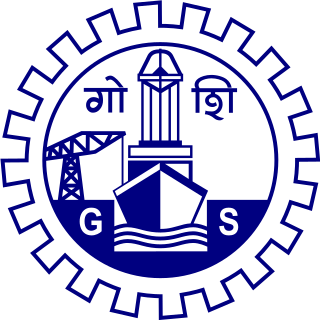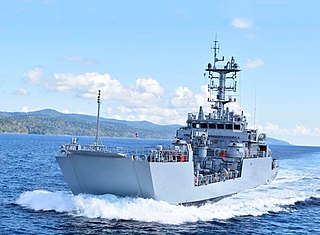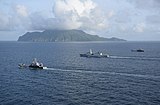
Mazagon Dock Shipbuilders Limited (MDL), formerly called Mazagon Dock Limited, is a shipyard situated in Mazagaon, Mumbai. It manufactures warships and submarines for the Indian Navy and offshore platforms and associated support vessels for offshore oil drilling. It also builds tankers, cargo bulk carriers, passenger ships and ferries.

Goa Shipyard Limited (GSL) is an Indian Government owned ship building company located on the West Coast of India at Vasco da Gama, Goa. It was established in 1957, originally by the colonial government of the Portuguese in India as the "Estaleiros Navais de Goa", to build barges to be used in Goa's growing mining industry, which took off after the establishment of India's blockade of Goa in 1955. In the wake of Portugal's defeat and unconditional surrender to India following the 1961 Indian annexation of Goa, it was requisitioned to manufacture warships for the Indian Navy and the Indian Coast Guard.

The Car Nicobar class of high-speed offshore patrol vessels are built by Garden Reach Shipbuilders and Engineers (GRSE) for the Indian Navy. The vessels are designed as a cost-effective platform for patrol, anti-piracy and rescue operations in India's exclusive economic zone. In 2023, one of the ships, INS Tarmugli, was donated to the Maldivian Coast Guard.

The Andaman and Nicobar Command (ANC) is a integrated tri-services command of the Indian Armed Forces, based at Port Blair in the Andaman and Nicobar Islands, a Union Territory of India. It was created in 2001 to safeguard India's strategic interests in Southeast Asia and the Strait of Malacca by increasing rapid deployment of military assets in the region. It provides logistical and administrative support to naval ships which are sent on deployment to East Asia and the Pacific Ocean.

The Saryu class of offshore patrol vessels (OPV) are advanced patrol ships of the Indian Navy built at the Goa Shipyard Limited. These vessels are capable of ocean surveillance and monitoring and can maintain control of shipping lanes. They can also be deployed to provide security to offshore oil installations, and other naval assets.

INS Kabra is a naval vessel named after an island of the Andaman and Nicobar archipelago. It belongs to the Car Nicobar class of high-speed offshore patrol vessels are built by Garden Reach Shipbuilders and Engineers (GRSE) for the Indian Navy. Kabra was eighth in a series of 10 Fast Attack Crafts. The vessels are designed as a cost-effective platform for patrol, anti-piracy and rescue operations in India's Exclusive Economic Zone.

The Shachi-class was a class of naval offshore patrol vessels supposed to be built by Reliance Defence and Engineering at its shipyard in Indian state of Gujarat. The project was scrapped by Ministry of Defense, India after an inordinate delay of 9 years.

INS Jarawa is a naval base of the Indian Armed Forces under the joint-services Andaman and Nicobar Command located in Port Blair in the Andaman & Nicobar Islands. It was commissioned in 1964.

INS Baaz is an Indian naval air station under the joint-services Andaman and Nicobar Command (ANC) of the Indian Armed Forces. It is located near Campbell Bay, on Great Nicobar island in the Andaman & Nicobar Islands. It is the southernmost air station of the Indian Armed Forces. It overlooks the Strait of Malacca as well as the Six Degree channel between Great Nicobar and the Indonesian island of Sumatra.

INS Sunayna is the second Saryu-class patrol vessel of the Indian Navy, designed and constructed indigenously by the Goa Shipyard Limited. It is designed to undertake fleet support operations, coastal and offshore patrolling, ocean surveillance and monitoring of sea lines of communications and offshore assets and escort duties.

INS Sumedha (P58) is the third Saryu-class patrol vessel of the Indian Navy, designed and constructed indigenously by the Goa Shipyard Limited. It is designed to undertake fleet support operations, coastal and offshore patrolling, ocean surveillance and monitoring of sea lines of communications and offshore assets and escort duties.

INS Sumitra is the fourth and last Saryu-class patrol vessel of the Indian Navy, designed and constructed by Goa Shipyard Limited. It is also the presidential yacht of India. It is designed to undertake fleet support operations, coastal and offshore patrolling, ocean surveillance and monitoring of sea lines of communications and offshore assets and escort duties.

The Indian Navy has been focusing on developing indigenous platforms, systems, sensors and weapons as part of the nation's modernisation and expansion of its maritime forces. As of November 2023, the Indian Navy had 67 vessels of various types under construction including destroyers, frigates, corvettes, conventional-powered and nuclear-powered submarines and various other ships. It plans to build up to a total of 200 vessels and 500 aircraft by 2050. According to the Chief of the Naval Staff's statement in December 2020, India has transformed from a buyer's navy to a builder's navy.

Mk IV LCU class vessels follow on class of Mk. III LCU operated by the Indian Navy. The Mk IV LCU can be deployed for maritime roles that require amphibious capabilities.

INS Sutlej (J17) is a hydrographic survey ship of the Sandhayak class in the Indian Navy, under the Southern Naval Command. Like other ships of the same class, this ship is also equipped with an Operating Theater and associated equipment needed to attend to medical emergencies at sea.

MCGS Huravee, formerly INS Tarmugli is a patrol vessel of the Car Nicobar-class of Indian Navy and the first ship in the series of four Water Jet Fast Attack Craft (WJFAC). The ship was commissioned by Vice Admiral HCS Bisht AVSM, Flag Officer Commanding-in-Chief, Eastern Naval Command. The indigenously conceived, designed and built ship, named after an island of same name in the Andaman archipelago is capable of operating in shallow waters at high speeds. Built for extended coastal and off-shore surveillance and patrol duties the warship is fitted with advanced MTU engines, water jet propulsion as well as latest communication equipment.
INS Bitra (T66), the second ship of Bangaram-class patrol vessel of the Indian Navy, is designed for interdiction against fast moving surface vessels and for search-and-rescue operations in coastal areas and in the exclusive economic zone. Named after Bitra atoll in Lakshadweep, the vessel was designed and built by Garden Reach Shipbuilders and Engineers. The diesel generators on board are supplied by Cummins India. The electronic equipment on board including satellite communication and global positioning systems is from Bharat Electronics Limited, ECIL and Hindustan Aeronautics Limited. Rear Admiral Sanjay Vadgaokar commissioned the fast attack ship in Vasco da Gama, Goa on 28 March 2006.
INS Batti Malv (T67) is the 3rd ship of the Bangaram-class patrol vessels of the Indian Navy, designed for interdiction against fast moving surface vessels and for search-and-rescue operations in coastal areas and in the exclusive economic zone. Named after the Battimalv Island in Nicobar, the vessel was designed and built by Garden Reach Shipbuilders and Engineers. The diesel generators on board are supplied by Cummins India. The electronic equipment on board including satellite communication and global positioning systems is from Bharat Electronics Limited, ECIL and Hindustan Aeronautics Limited.

SLNS Sindurala pennant number P624 is an advanced offshore patrol vessel (AOPV) of the Sri Lanka Navy. It is the sister ship of SLNS Sayurala.


















